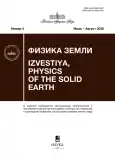Izvestiya, Physics of the Solid Earth
The journal «Physics of the Earth», founded in 1965, publishes the results of original theoretical and experimental studies in the fields of physics of the Earth's interior and applied geophysics. The journal publishes articles written by researchers of the Russian Academy of Sciences and scientific institutions of the Russian Federation. Articles by foreign authors are also accepted for publication.
Editor-in-Chief
Morozov Yu.A., corresponding member of the Russian Academy of Sciences.
Media registration certificate: № 0110188 от 04.02.1993
Ағымдағы шығарылым
№ 4 (2025)
Articles
On the Relationship Between RTL and B-Value Anomalies of Seismicity
Аннотация
 4-20
4-20


South Tien Shan Earthquake on January 22, 2024, Mw = 7.0: Filling a Seismic Gap?
Аннотация
 21-34
21-34


Systematic earthquake forecast
Аннотация
 35-49
35-49


Typical Precursor Anomalies of the 6 February 2023 Kahramanmaraş, Türkiye, Doublet, Mw 7.8 and Mw 7.6 and the 2004 Sumatra-Andaman and the 2011 Tohoku-Oki Mw 9.0+ Mega Earthquakes
Аннотация
 50-62
50-62


Geodynamic manifestations of the seismic process in the area of the Simushir earthquakes on November 15, 2006 and January 13, 2007
Аннотация
 63-79
63-79


Observations of the Blomstrand Glacier Activation in the North of West Spitsbergen Island Based on Data from a Single Seismic Station
Аннотация
 80-92
80-92


Seismo-electromagnetic and seismo-ionospheric phenomena: from the earliest works of G.A. Sobolev to the present day
Аннотация
 93-114
93-114


Laboratory Studies of Seismoelectric Conversions in Porous Media. I. Retrospective and Perspective
Аннотация
 115-133
115-133


Effect of direct heating on cracking process in the uniaxially compressed sample
Аннотация
 134-143
134-143


Experimental study of a porous medium destruction during a pressure drop
Аннотация
 144-158
144-158


Role of microstructure consideration in modeling the effective elastic properties of limestones
Аннотация
 159-177
159-177


Features of energy distributions of acoustic emission signals during rock deformation: Laboratory experiment and computer simulation
Аннотация
 178-186
178-186


On the relationship between Gutenberg-Richter b-value and the fractal dimension of seismicity according to computer and laboratory modeling data in spaces of different dimensions
Аннотация
 187-198
187-198


On the role of the sliding surface macrostructure in the origin and development of dynamic instability in the upper part of the Earth’s crust
Аннотация
 199-215
199-215


Parametric effects in recent geodynamics
Аннотация
 216-236
216-236


Seismogeological Conditions of Preparation of Dangerous Earthquakes in Fault Nodes
Аннотация
 237-252
237-252












